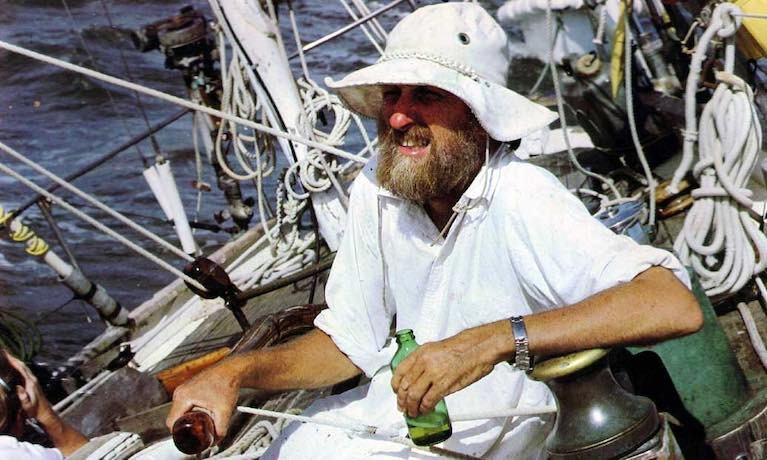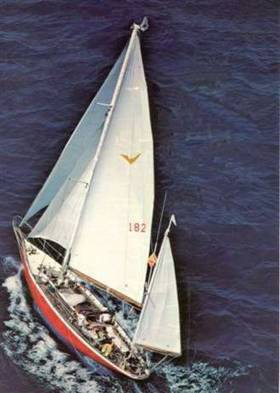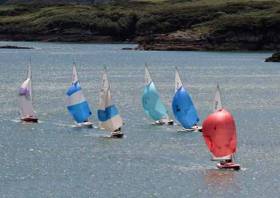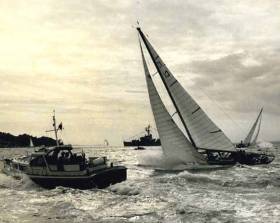Displaying items by tag: Don Street
You may remember a little while back, we were recording the sad yarn of Don Street losing his beloved vintage clinker-built service tender Red Rocket when a freakish October gale swept over Glandore pier, and removed everything in its way, including boats stowed where they’d been safely stowed for many a year. Well, Red Rocket was among them, gone to smithereens after 41 years of faithful service. But after a farewell libation or two in honour of her memory at the outer pierhead as soon as things had settled down a bit, 90-year-old Don set to with an almost nationwide search for something similar, as he wouldn’t dream of bringing anything manufactured in synthetic rubber alongside his beloved vintage International Dragon Gypsy.
We thought the search had become too intense when we got a brief email from him recently saying he’d got the dengue, for dengue fever is no laughing matter. But it turned out that the accursed predictive text, which those of us bewildered by much of modern IT find a hellish nuisance at the best of times, had struck yet again. It seems Don was only in a bit of a rush to tell everyone that he had the dinghy, that his son Richard in West Wicklow had managed to acquire possession of an ideal dinghy which had been sourced via the more obscure corners of the internet by the man who is the real foundation of just about everything worthwhile that has happened in Glandore for several decades, the Blessed Kieran O’Donoghue of the Glandore Harbour Inn and much other good work that is largely done by stealth.
The circumstances were such that this 14ft edge-glued epoxied sweety had to be taken untested. But Richard like his father has an eye for a boat - as too had Kieran O’D in viewing the first vague image on-screen - so it wasn’t until now that Richard felt he’d be within the pandemic regulations taking the new boat for a test row on Blessington Lake, aka Lough Poulaphouca, where he is one of the stalwarts of the thriving GP14 class. The photo says it all. Thanks to the clever construction, she’s as light as a feather, thanks to the classic design the transom sits properly clear of the water when there’s just a solo oarsman aboard, and yet it’s obvious she’ll be capable of carrying a good load when required, and at a handy speed too.
So despite the pandemic, the job has been done - and done well.
Don Street of Glandore and the Caribbean celebrated his 90th Birthday in distance-compliant-style with the Glandore Dragons in July 2020. And as he has had his writings about sailing published regularly - both in books and magazines - since 1964, after being encouraged to go for it by no less than Nobel Laureate for Literature John Steinbeck, it is reckoned that he is now the world's senior practitioner of the ink-and-salt-water trade.
But while 2020 brought much pleasure and celebration, it also brought a special sadness, as the Street family lost an old friend. We let Don take up the tale:
"Forty years ago, my Venezuelan friends taught me how to say good-bye to sailing friends who had crossed the harbour bar for the last time on their long voyage to the sailors' Valhalla, where the winds are fair and warm, and the seas moderate.
You walk to the end of the pier with your favourite drink, hoist it as a toast to the departed friend, drink half, then pour the other half into the sea for the departed sailor.
 A time for celebration – all set up for Don Street's 90th birthday race in Glandore on July 25th 2020
A time for celebration – all set up for Don Street's 90th birthday race in Glandore on July 25th 2020
Glandore Harbour is sheltered in all directions except South East, so no one worried to much when a SW gale was predicted the night of October 17th 2020. Unfortunately, the gale must have had a lot of south and a little east of south in it. This created a big surge in the Harbour, and it was a full moon with a big spring tide.
Red Rocket, the Street family's 16' light clinker/lapstrake dinghy that had given 41 years of yeoman service to our family and many others in Glandore, was, along with a number of other boats, swept off the high inner pier wall and destroyed.
Bits and pieces of Red Rocket were spread over the harbour, and during the following days, some of the pieces drifted ashore. With my wife Trich, I decided we'd to give Red Rocket a proper send-off in the fashion with which I always said farewell to those sailing friends who have departed to the maritime Valhalla.
 In her sailing and racing days, the very handy Red Rocket really was painted a bright red. But even when painted with whatever colour happened to be available that year, she gave forty years in all of the unstinting good service
In her sailing and racing days, the very handy Red Rocket really was painted a bright red. But even when painted with whatever colour happened to be available that year, she gave forty years in all of the unstinting good service
The word spread through the village and beyond to as many sailors as possible who'd had a connection to Red Rocket. The plan was to assemble on Glandore pier at 1100 Saturday with their favourite drink in hand and properly say good-bye to Red Rocket while bits and pieces of her were still tossing in the harbour.
Before everyone hoisted their drinks. I told the story of Red Rocket. Many of the assembled sailors knew of parts of the Red Rocket saga, but few knew it all.
In 1979, it was the Golden Jubilee of the Irish Cruising Club, and in July, the Cruising Club of America, the Royal Cruising Club, and Scotland's Clyde Cruising Club assembled with the Irish Cruising Club at the Royal Cork Yacht Club in Crosshaven to begin a Cruise-in-Company westward to Glengarriff, where the ICC had been founded 50 years earlier.
All our cruising focus at the time was on the Caribbean, where our yawl Iolaire was based. But as we'd many friends we'd like to greet in this mixed fleet at Crosshaven, I calculated the tide for the Owenabue river and rented a rather non-descript dinghy from the dinghy rental service in Crosser two hours before high tide, so that with minimal rowing Trich and I could float upon the flood seeing friends on various boats, and then return with equal ease on the ebb, socialising and visiting.
There was a nice-looking clinker 16ft dinghy that I wanted to rent but was unable to do so because one oar was broken. When returning the non-descript dinghy we'd used, I again admired the 16ft dinghy, but the boat hire operator did not share my enthusiasm, as renters claimed it was too tippy. The upshot was he offered to sell the dinghy to me, with oar repaired and delivered to Glandore, for IR£150. I immediately agreed to buy.
 Red Rocket's workaday appearance successfully disguised a real thoroughbred, bought for just IR£150 in 1979
Red Rocket's workaday appearance successfully disguised a real thoroughbred, bought for just IR£150 in 1979
Upon arrival in Glandore, the horrible orange colour was changed to red, the same red as the 46' engineless yawl Iolaire. Iolaire was doing so well racing in the Caribbean that she was known as The Old Red Race Horse.
In the 70s and into the early 80s in West Cork, part of the town festivals that each port ran were rowing races with cash prizes. There were races for various age groups, all men, all women, and mixed. That first year, the dinghy earned more in prize money than I paid for her, but I never saw the money. The kids spent the winnings on chips and soda, the older contestants on booze and beer. By the end of the season, she was known as Red Rocket, a name that has stuck with her even though in her later years, after we'd sold Iolaire, she'd appear in whatever paint was available and latterly had been blue.
The boats that were rowed in the regattas were pretty much whatever could be found and usually quite heavy. So for my daughter, Dory, aged 16, and her friends, I rigged the 16ft Red Rocket to be rowed four-oared. She was the smallest four-oared boat in the circuit, and when the girls first started rowing as a team, Red Rocket looked like a drunken water spider. But they learned to row well and turned in respectable performances against the larger 20 and 22-foot boats.
The following year, Glandore Harbour Rowing Club commissioned Jackie Mons to build a light clinker 20' four-oared boat. In Cu na Mara, the Red Rocket-trained girls were practically unbeatable for three years until the team broke up and gals departed to university and out of Glandore.
In this period, there was little enough local sailing in Glandore except for Kieran, and Dermot O'Donohue match racing their two Dragons, Pan and Fafner. To get sailing, I rigged Red Rocket as a cat ketch, with a loose-footed lug as main, and a mizzen which was also a lug but unique in Glandore, as it was rigged Chesapeake Bay-style with a sprit, rather than a normal boom.
A single lee-board was rigged. It was secured on the lee side by water pressure on the hull, with the top secured to a line that went through a hole in the middle of the centre thwart. The leeboard was switched on every tack to the new lee side, and that was Sean Thompson's job, as he was the biggest and strongest and - at 13 - the oldest member of the crew, with the other two being Donald and Richard Street, aged 11 and 9.
Red Rocket was a great training boat with plenty of strings to pull, and she gained extra kudos among Glandore's growing group of junior sailors, as she was much faster than the expanding fleet of Optimists.
 The 1933-vintage Dragon Gypsy has provided both racing and sail training services to many generations in Glandore
The 1933-vintage Dragon Gypsy has provided both racing and sail training services to many generations in Glandore
But the lure of the Dragons couldn't be resisted, and I bought the 1933-vintage Anker & Jensen-built Gypsy. Red Rocket's sailing rig was discarded, and she became our water taxi for the next thirty-five years. All the crews of Gypsy not only learned to tie knots - many more knots that they learn in the ISA programme – but they also learn to row properly and enjoy it, too, while they kept our carbon footprint at zero as other kids buzzed noisily around with outboards on RIBS.
They learned to pivot Red Rocket in one spot, clock-wise and counter-clockwise, and also how to row in astern to back Red Rocket neatly into the crowded dinghy pontoon in the lee of the Glandore pier, as it is much easier to get in and out of a dinghy via the stern rather than over the bow. I had figured this out over forty years ago, and Iolaire's dinghies were always secured to the dock or float stern rather than bow on.
Sailors who had not previously crewed on Gypsy asked me why Red Rocket had beautiful white fendering all along the port gunwale, but nothing on the starboard side other than a couple of suspended blue fenders. I point out that I like and try to follow old yachting traditions. Owners and guest come on board on the starboard side. Paid hands and tradesmen on the port side….. We always board Gypsy on the starboard side. But alas, we will no longer do it from Red Rocket, and we bid farewell to her in traditional style, our faithful friend of forty years".
 Don Street waxes lyrical – his farewell to Red Rocket in a ceremony at the end of the pier brought the Caribbean to Glandore
Don Street waxes lyrical – his farewell to Red Rocket in a ceremony at the end of the pier brought the Caribbean to Glandore
You might think that in West Cork, which is something of Clinker Punt Central, replacing Red Rocket is proving an easy business as Don accelerates his search, having had his COVID-19 jab last week. But at 16ft overall, she was a slightly unusual length. For although 12 and 14 footers are common, there then seems to be a 4ft leap to the 18-19ft, which is the regular length of the standard Irish lake boat.
As well, though she may look quite heavily built, Red Rocket was surprisingly light, and Don would hope to continue that characteristic. Thus his choices are closely-defined. Perhaps a 16ft version of the edge-glued clinker ply Rankin dinghies of Cork Harbour might fit the bill?
Either way, Don prefers wood, and he likes a bargain, so you see the parameters of this challenge. But if you have or know of an available boat that comes anywhere near the now-legendary Red Rocket's many virtues, please contact Don Street at [email protected]
 A beautifully-restored 14ft Rankin sailing dinghy. Being built with edge-glued clinker ply, they're remarkably light, and a 16ft version of this boat with the same beam but without the centreboard casing might make an ideal replacement for Red Rocket
A beautifully-restored 14ft Rankin sailing dinghy. Being built with edge-glued clinker ply, they're remarkably light, and a 16ft version of this boat with the same beam but without the centreboard casing might make an ideal replacement for Red Rocket
Don Street is "Sailor of the Month (International)" for December
Don Street of Glandore and the Caribbean is the Afloat.ie "Sailor of the Month (International)" for December in celebration of his continuing and inspirational joy in sailing at the age of 90, and in honour of the remarkable contribution he has made to our sport, both in the many areas of his active and successful involvement afloat and in his writing of many books – cruising guides and technical manuals alike - which have been a source of encouragement for his international legions of followers.
 Don Street in Glandore mode – you wouldn't see him in a tweed jacket in Antigua…
Don Street in Glandore mode – you wouldn't see him in a tweed jacket in Antigua…
While his passion for sailing is a virtually lifelong enthusiasm, his nautical writing life has stemmed from a chance meeting with a Nobel Laureate in Literature. Many years ago, at a convivial supper while Caribbean cruising, one of those at the table was novelist John Steinbeck, who was also sailing down the isles. With Don's salty tales flowing ever more entertainingly as the evening progressed, somebody inevitably said he really should put together a book of sea writing.
"But I know nothing about grammar" said Don, "and my spelling's terrible".
Upon which the great Steinbeck rumbled into life: "It's the job of the Editors and the Proof Readers to get that right. Just you go ahead and write the stories. Those are the uncut diamonds that any real publisher's people should be happy to work with".
 Don on the big day in Glandore at the helm of his vintage Dragon Gypsy, which is only a couple of years younger than he is
Don on the big day in Glandore at the helm of his vintage Dragon Gypsy, which is only a couple of years younger than he is
Don's sailing is such a mixture of experiences that anyone can find something of interest in it, and for a connoisseur, it's all pure gold. In much of 2020, the lockdowns meant he was restricted to Glandore and the Dragons, but even with the latest Level 5 closure, there's still a gleam in his eye as he contemplates the remote possibility of the RORC Caribbean 600 at the end of February.
This 1985 vid trailer gives an introductory idea of Don and Iolaire, and the special impression they have made on several generations of sailors:
Don Street Celebrates 90th Birthday with Stylish International Dragon Racing in Glandore
Much of the rest of the sailing world may be whirling in coronavirus confusion, but in serene and elegant Glandore in West Cork. the strong local division of classic and modern International Dragons went smoothly into their 14-race Dragon Derby at the weekend. And last Saturday’s racing had a very special flavour, as it marked the 90th birthday of international super-sailor Don Street, who must have done more sailing his time in a greater variety of boats – inshore, offshore and oceanic – than possibly all of his fellow-members of Glandore Harbour Yacht Club combined.
 ……but as start time approaches, a youthful crew appears from below decks
……but as start time approaches, a youthful crew appears from below decks
Don’s classic Dragon Gypsy – IRL 15 – is of much the same vintage as himself, and is undoubtedly the oldest actively raced Dragon in Ireland, one of a very elite group of seniors worldwide - as is her owner-skipper. It says much for the profound qualities of the 91-year-old Dragon design that Don Street and his colleagues in Glandore should put so much enthusiasm in keeping this very special division of the class actively alive. Happy birthday, Don……
 Glandore Dragons closing in on the mark
Glandore Dragons closing in on the mark
 A very special birthday party in Glandore – at 90, Don Street (second left) enjoys his post-race parties as much as ever.
A very special birthday party in Glandore – at 90, Don Street (second left) enjoys his post-race parties as much as ever.
They say bad news travels fast. But the news that the 48ft 1905-built yawl Iolaire has been lost, after an inadvertent gybe in heavy weather drove her onto rocks – fortunately without loss of life or injury - off Ibiza on July 26th, has only been seeping slowly into international maritime awareness writes W M Nixon.
Iolaire had several owners, including ocean racing pioneer Bobby Somerset. But when the youthful yet already very experienced American sailor Donald M Street Jnr bought her in 1959 at St Thomas in the Caribbean, it was for only $100 dollars, as she had been deemed a write-off after being driven ashore on the beach because of a failed mooring shackle.
"The 48ft 1905-built yawl Iolaire has been lost, after an inadvertent gybe in heavy weather drove her onto rocks"
Some write-off…….Don soon had her sailing again, and continued the restoration over the years, giving her a yawl rig which was British-style John Illingworth masthead cutter forward of the mainmast, and American yawl with vast mizzen staysail down aft. Under this rig he cruised the length and breadth of the Caribbean with no auxiliary engine, writing pilot books for the islands, helping in the development of the charter industry, giving advice as a consultant in the marine insurance business, and becoming an internationally-recognised author on seamanship as well.
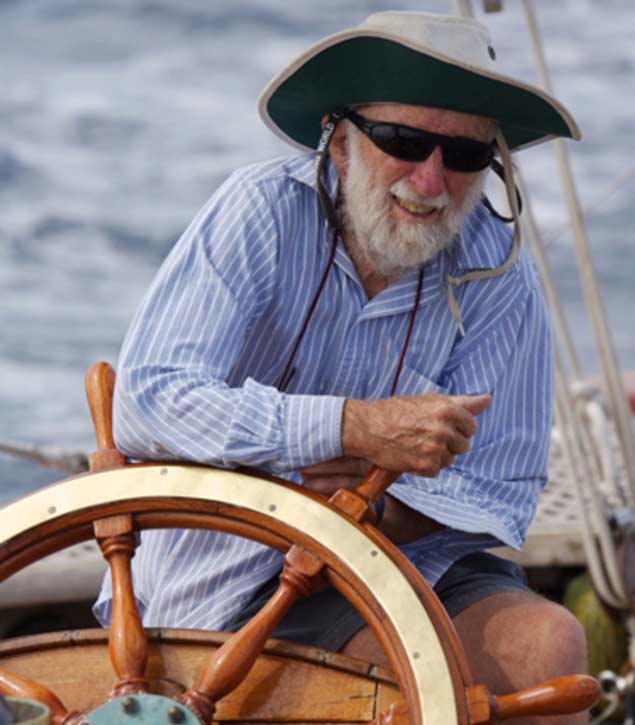 Don Street in dress-down style for Caribbean sailing. Yet when he sailed the International Dragon Class Gypsy across hundreds of miles of open water from Glandore to Brittany, he managed to bring a set of immaculate and stylish clothes for shoreside gatherings at a Festival of Sail.
Don Street in dress-down style for Caribbean sailing. Yet when he sailed the International Dragon Class Gypsy across hundreds of miles of open water from Glandore to Brittany, he managed to bring a set of immaculate and stylish clothes for shoreside gatherings at a Festival of Sail.
Somehow he also found time to cross the Atlantic with Iolaire seven times, and took part in the Golden Jubilee Fastnet Race in 1975, while in high summer he became well-known in Glandore in West Cork where his wife Trish had inherited Rock Cottage, and he was among those involved in the development of the classic International Dragon class at this most beautiful harbour.
It was from Glandore that Iolaire was finally sold in 2011 after an astonishing 52 years of ownership, but Don Street’s involvement in sailing continues with winters in the Caribbean as a pilotage expert on large yachts, and summers with the Dragons in Glandore, where he sails the 86-year-old Gypsy.
It was in Glandore that he was told of Iolaire’s loss, and it was made more poignant by the fact that July 26th had been his 89th birthday. Yet in classic Don Street style, he very quickly pointed out that it wouldn’t have happened if the crew had been deploying one of his inventions, a gybe-preventer which could be made operational without any crewmember having to go forward of the mast.
But while Iolaire may be gone, Don Street still sails on, and currently he is engrossed in plans to take Gypsy to the International Dragon Class 90th Anniversary Regatta at San Remo in Italy from October 5th to 13th. There, her skipper will be the oldest helm from the Northern Hemisphere (he is globally bettered only by Australia’s 92-year-old Gordon Ingate), and Gypsy will certainly be one of the oldest boats.
We presume that Gypsy will be road-trailed to San Remo with the help of friends and family. Nevertheless the presence of the high seas has never prevented Don Street from getting Gypsy to some appropriate major international event under sail. Some years ago, he decided that Gypsy should take part in the Festival of Sail in Brittany, and he and a crew of two simply sailed there in this Dragon with her open racing-style cockpit.
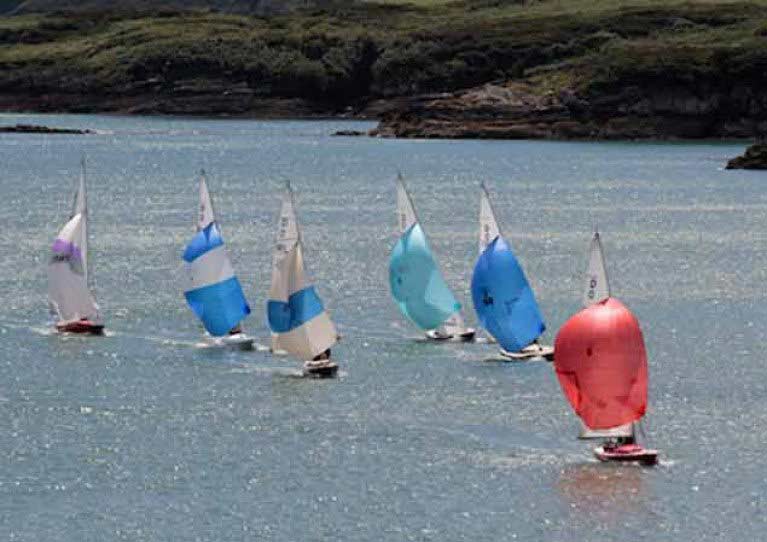 The classic International Dragons at Glandore are now one of Don Street’s main focal points of sailing interest. Photo Katherine Hayes
The classic International Dragons at Glandore are now one of Don Street’s main focal points of sailing interest. Photo Katherine Hayes
Not only that, but once they got there, her doughty skipper appeared ashore in a smooth style at variance with his usual Caribbean appearance. For under Gypsy’s foredeck for the entire voyage across the Celtic Sea and the mouth of the English Channel, there had been carefully stowed a tough waterproof plastic bag containing the skipper’s immaculate reefer jacket, the whitest of white shirts, a pair of classic sailing trousers in neat order, and his cherished Royal Ocean Racing Club tie.
When Gypsy finally reappeared back from Brittany in the mouth of Glandore Harbour, running in under spinnaker, she was very deservedly given the welcoming salute with a honorary salvo of the starting cannons from the Glandore Harbour Yacht Club.
Recycle Your Dragons For Younger Sailors, Calls Class Veteran
#Dragon - Dragon class veteran Don Street is calling for Dragon associations the world over to find old or disused vessels for restoration and encourage younger sailors to keep the class going forward.
As Scuttlebutt Europe reports, Street’s plans would see under-25s taking on older fibreglass Dragons to bring them back into racing shape at minimal cost, with assistance and advice from their national bodies and top sailors in the class alike.
If anyone has the determination to see through such an ambitious project, it’s the ‘Guru of Glandore’ – to whom our of Winkie Nixon paid tribute earlier this year.
Veteran Sailor Gordon Ingate An Inspiration For Us All
When Ireland’s senior Dragon sailor Don Street (87) of Glandore bids us to pay attention, we always do, as Don’s experience in many areas of sailing is unrivalled writes W M Nixon.
But when Don suggests we all sit up and take notice of the sailing of Gordon Ingate of Australia, there are many of us already right there with the Guru of Glandore. For Gordon Ingate of Tasmania makes the well-tested slogan “Sailing: A Sport for Life” seem barely adequate, as he is still winning serious races at the age of 92, and everything about the man is an inspiration.
His most recent achievement was a clear victory in the Australian Dragon Championship 2018 in Victoria, which concluded at the weekend. Racing against a fleet of 26 boats, and crewed by Amy Walsh and David Giles, his boat Whimsical was anything but. His clear victory of 4 points including three bullets was about as un-whimsical as you can get.
But then, this perhaps greatest Corinthian sailor the world has ever seen seems to specialize in clearcut wins in boats whose names indicate a certain vagueness. He first leapt to international renown in the 1965 Admirals Cup, when he was one of the Australian team with his classic Robert Clark-designed Caprice of Huon
Caprice was an elegant veteran of 1948 or thereabouts, strongly built of the finest Huon pine. But Ingate and his crew had her in such perfect racing trim in 1965 that she cut a swathe through the fleet, particularly in the Solent racing where he made off with major trophies in Cowes Week. Two years later in 1967, he and Caprice were back again with team mates who matched his previous performance, and they won the Admiral’s Cup.
 Gordon Ingate – still winning majors at the age of 92
Gordon Ingate – still winning majors at the age of 92
Thereafter, he was very much a force to be reckoned with at Olympic and America’s Cup level. But he’s at his best when racing his own boat tuned to his own very high standards, and racing in fleets which provide the proper settings for his skill sets. Grown-up sailing, in other words.
Thus it was altogether appropriate that when a celebrity was sought to fire the starting cannon for the recent Rolex Sydney-Hobart Race, they asked Gordon Ingate to do the honours. The Australian commentator didn’t even have to think of saying who he was. And now he has won in the Australian Dragons Nationals. Yet again.
That said, our own Don Street is as full of enthusiasm as ever, and his latest evidence of eternal youth is a drive to get the Glandore Dragons to permit racing crews of four. This is so that any youngsters keen to learn about these wonderful boats can get a taste of it without initially being expected to play a crucial crewing role.
The ancient Howth 17s tested the idea some years ago. It worked so well that racing four up is now the preferred option for many boats. And it has been so successful in introducing newcomers to the class that the fleet is in better order than ever – not bad going for a class founded in 1898.
 The Glandore Dragons – veteran skipper Don Street argues convincingly that they should permit a fourth hand aboard for racing to encourage class growth. Photo Kathleen Hayes
The Glandore Dragons – veteran skipper Don Street argues convincingly that they should permit a fourth hand aboard for racing to encourage class growth. Photo Kathleen Hayes
The Sailing & Boating Wonders of Ireland's West Cork Coast
The sailing paradise of West Cork on Ireland's south-west coast is at its best right now, and the south coast fleets are already heading that way for the traditional West Cork regattas in August. WM Nixon reflects on the magic sailing region of West Cork.
West Cork is as much of a frame of mind as a specific place. Officially, we might suppose it to extend all the way along the Rebel County's coast from the Old Head of Kinsale to Dursey Island away in the far nor'west, up at the north side of the wide entrance to Bantry Bay. But this doesn't necessarily mean that all the folk in the hinterland north of this coastline see themselves as being in West Cork.
As for boat people, our limits are much more narrowly defined. If you're afloat down there, West Cork is that sublime but compact bit of coastline between Galley Head and Mizen Head, just 38 miles as the gannet flies. It's the ultimate lotus land, with an interesting scattering of islands, blessed moreover with an abundance of sheltered natural harbours each with its own port town or village vying with its neighbours in colourful character. And visible from much of it is the Fastnet Rock, mysteriously a place of the remotest ocean despite being only a matter of four miles from the nearest land at Cape Clear.
In this magic land, the local mini-capital is of course Skibbereen, the very essence of a rural market town. But on the coast, the very different harbours of Schull, Baltimore, and sometimes even Glandore have been seen over the years as the sailors' capital of West Cork. Recently, however, it is Baltimore which has gone from strength to strength to affirm its position as the sailing capital of the southwest, and spending a June night there as summer settled comfortably over Munster reinforced the impression of its pre-eminence.
We were on a bit of a land cruise, so the bed for the night was in the Waterfront, the hotel where Room 12 is just about as near to the beating heart of Baltimore as you can get. Aboard a cruiser in Baltimore, you can enjoy that splendid isolation which a boat so easily confers. But in Room 12 on top of the Waterfront's northwest corner above the square, the busy life of the little port town bubbles about you, and the views across to Sherkin Island and over the country to Mount Gabriel get even more perfect with the approach of sunset.
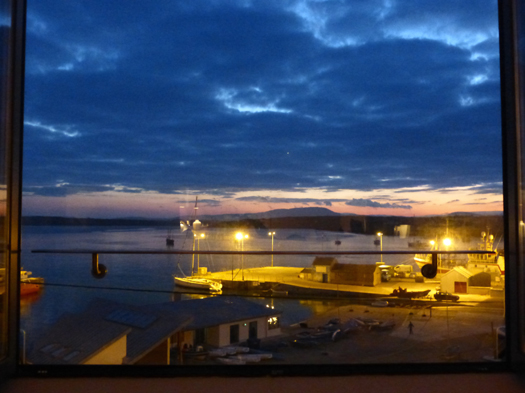
The view from Room 12 at the Waterfront in Baltimore. The sun has set beyond Mount Gabriel, but somebody is busy launching a newly-arrived RIB by floodlight, and the buzz from the square below is still rising. Photo: W M Nixon
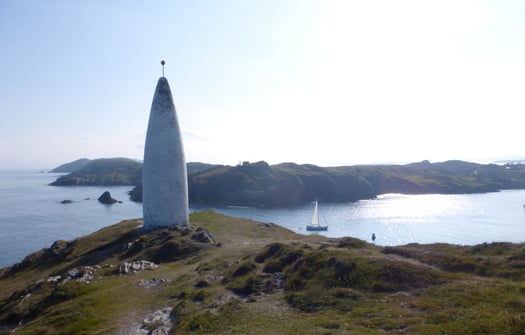
It has to be one of the best arrivals in world sailing. A cruiser enters Baltimore beneath the Baltimore Beacon, aka Lot's Wife. Photo: W M Nixon
It was fifty years ago when I first sailed in to Baltimore, coming in from the west on a round Ireland cruise, and entering port close under the beacon – Lot's Wife they call it – to find a quiet little place which showed some signs of a former prosperity, and hinted at better times to come. Back in 1964, it still had its railway station, but the West Cork Line was in its final year and was soon to be totally closed. Before that happened, later that summer when Baltimore Sailing Club hosted Dinghy Week for the Irish Dinghy Racing Association, the Firefly Class in Dun Laoghaire – mostly university boats – had been able to have a Tuesday night race. Then they'd towed their boats into Dun Laoghaire station on the launching trolleys, put them onto a CIE flat truck, and found them on Friday night safely delivered by rail the entire way to West Cork, offloaded ready at the harbourside station in Baltimore, and waiting for the arrival of thirsty crews keen for a bit of sport.
Mostly, they'd got themselves there by overloading some little car belonging to somebody or other's mother, so the fact that they disdained to use the railway themselves would help to explain why such a charming amenity was doomed. Since then, of course, Baltimore Railway Station from 1969 until recently had become Ireland's first Glenans base. But life moves on, the Glenans model doesn't seem to work any more in Ireland, so now the former station is for sale by the powers-that-be, and there are ructions being raised about it all which should keep everybody nicely exercised through the rest of the summer.
It was another French import which currently sets the pace in Baltimore. Around 1980 a young Breton fisherman, Youen Jacob, came into the harbour, and in time he settled there. To say that Youen Jacob has played a major role in Baltimore life is understating the case. It is he and his family who have developed the Waterfront – quite a challenge in somewhere as conservative as West Cork – and with Youen Jnr's Jolie Brise restaurant and guest house beside it to provide an alternative aspect of good Breton cuisine, the Jacob family's establishments have given a healthy new configuration to Baltimore's miniature harbourside square, and have settled in so well you could be forgiven for thinking the little town was built around them.
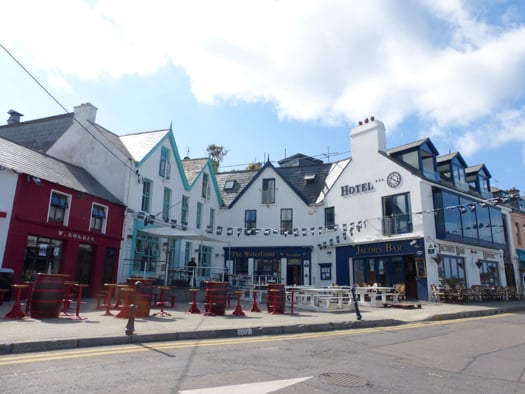
The Waterfront (right) and Jolie Brise at the south side of the mini-square in Baltimore bring a welcome breath of Brittany to West Cork. Photo: W M Nixon
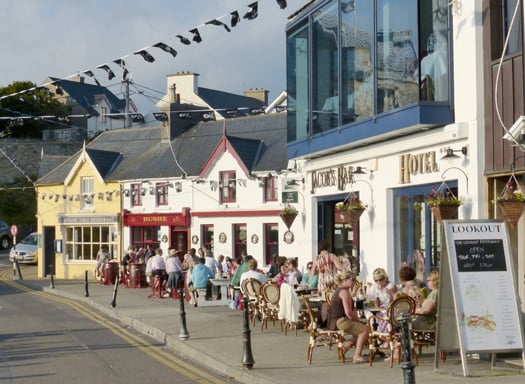
It's party time in Baltimore. The al fresco lifestyle is expected in West Cork in summer. Photo: W M Nixon
There are times when you'd understandably think this is the hub of the maritime universe, and why not? But if, during a quiet cruise, you think you might find it too hectic at night when the joint really is jumping, the sensible thing is to call by at lunchtime when everybody is out at the islands and Baltimore is refreshed and catching its breath for the next night's partying. Then in the evening, you can pop over to Sherkin Island where peace will reign while Baltimore ramps up the socializing.
Up in our eyrie above the square, we savoured the life of this busy little port. It's not quite a 24-hour town, but late at night boats were still being launched by floodlight, and conviviality continued in the square. Finally, peace descended, and though most folk were slow to stir early in the morning, the first ferries were coming in, and a workboat headed out for the islands, going past Graham Bailey's Peel Castle, the remarkable bisquine-rigged variation on a 50ft 1929-built Cornish lugger which is seen at her best on her mooring in Baltimore harbour. This is only right and proper, as the restoration and re-configuration of Peel Castle took place nearby, just up the Ilen River at one of the boatyards at Oldcourt.
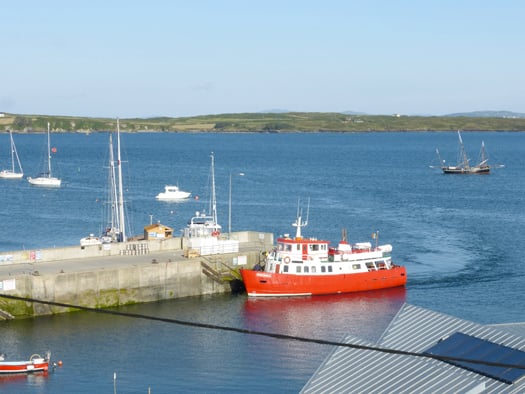
Good morning Baltimore, how are you? The first ferry arrives in from Sherkin Island. Photo: W M Nixon
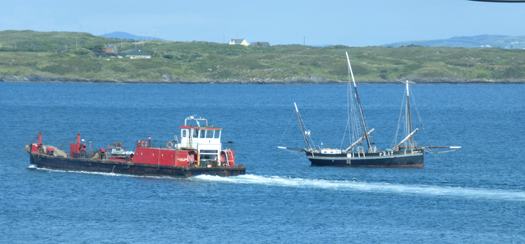
Getting the day's job started. A workboat heads out towards Sherkin past Graham Bailey's distinctive Peel Castle. Photo: W M Nixon

Peel Castle in all her glory in the middle of Baltimore Harbour. Restoring this 1929-built 50ft Cornish fishing boat and giving her a bisquine rig took Graham Bailey eight years of dedicated work at Oldcourt. Photo: W M Nixon
Another Baltimore revival which gets our approval is the restoration of the castle right in the middle of town, the "tigh mor" which presumably gives the place its name. We suffer from a widespread ruins overload in Ireland, so it's refreshing to find that somebody upped and took action, brining a ruin back to life and giving Baltimore a very effective signature focal point with a useful function. You could do the same to good effect at Dromineer on Lough Derg, where the ruined castle is an eyesore.
But you don't even have to leave the Baltimore area for a worthwhile restoration project, as just across the harbour beside the pier on Sherkin is the roofless ruin of the 15th Century Franciscan friary which we know looks much better with its roof back on, even if it has been missing since the 1770s.
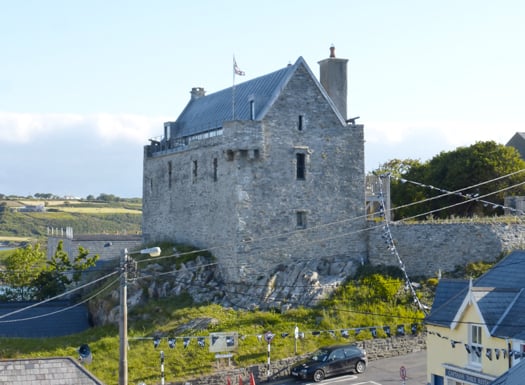
The restoration of the castle at Baltimore has given welcome and useful new life to a former ruin. Photo: W M Nixon
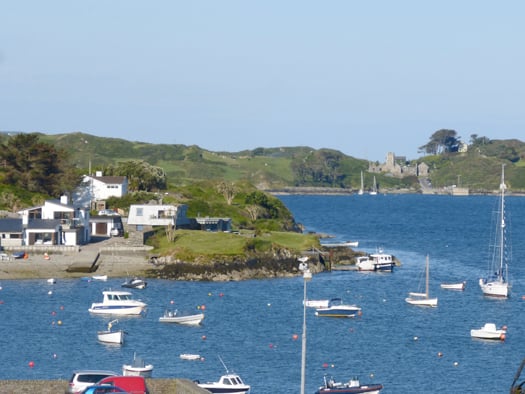
The Cove on the south side of Baltimore Harbour has some very desirable real estate. Photo: W M Nixon
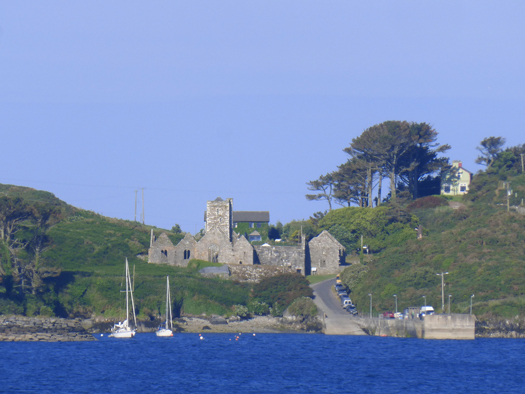
Thanks to its use as a film set in 1973, we know that the friary on Skerkin Island looks much better with it roof in place. Photo: W M Nixon
We know this because, in 1973, the makers of a TV film managed to get permission from the OPW to put a temporary but very convincing roof in place, and it looked so utterly right. The film was the unfairly forgotten Catholics, based on the novel of the same name by Belfast-born Brian Moore, and memorably starring Trevor Howard as the troubled Father Abbot. Even in this usually overlong blog, there isn't space to go into the details of the story, but it's worth viewing Catholics at the very least to see how well Sherkin friary looks with a roof. Alas, when filming was done the production company religiously (how else?) adhered to the OPW's demands to return the very attractive little old building to its ruinous state, and there it sadly sits.
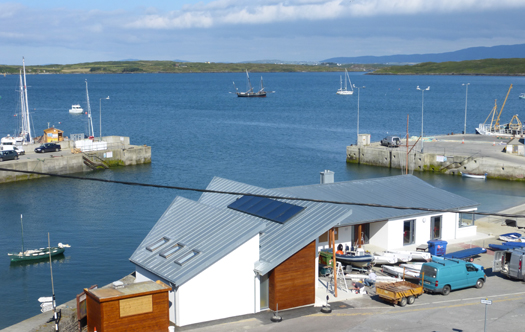
This year's work on Baltimore Sailing Club has made it even more of a local asset. Photo: W M Nixon
But as regular readers of Afloat.ie will know, other refurbishment and extension work has been under way in Baltimore, with the Sailing Club in fine fettle in its extended premises which look so well you'd think it's all new. It's certainly all of a piece with Baltimore's vitality, which contrasts with other little West Cork ports. In Baltimore, the key to it all is the fact that the Waterfront gallantly stays open all year round. But at present in Schull and Glandore, the main hotels don't even open in summer.
Doubtless in time, and sooner rather than later, both establishments will be brought back to life. But for people genuinely cruising, the absence of a hotel or two doesn't matter that much in an area where the abundance of cruising options and hospitable pubs with good food is almost bewildering. And around Baltimore in particular, there's always something going on.
The wholesome 1893-built cutter Eva (later known as Guillemot) was restored at Oldcourt, which is only a few miles from her birthplace 121 years ago on the Baltimore waterfront. Brian Marten's project to have Eva re-born and continue as Guillemot has come to a successful conclusion after she went through several vicissitudes before he happened upon her, but a visit to Oldcourt will reveal many other boat restoration, re-build and re-birth projects at various stages, including some which - as our accountancy friends would insist on putting it - are no longer going forward.
Be warned, however, that any visit to Oldcourt in any capacity whatever is likely to take longer than you expect, as there's simply so much to see. And they're at every stage, from projects just starting, through projects stalled, to projects nearing completion, while inspiration was being provided by a visiting boat, Darryl Hughes' immaculately-restored 1937 43ft Tyrrell ketch Maybird, which was berthed for a while at Oldcourt to let boatbuilder John Hegarty take off measurements in order to build a traditional clinker dinghy which will fit on board.
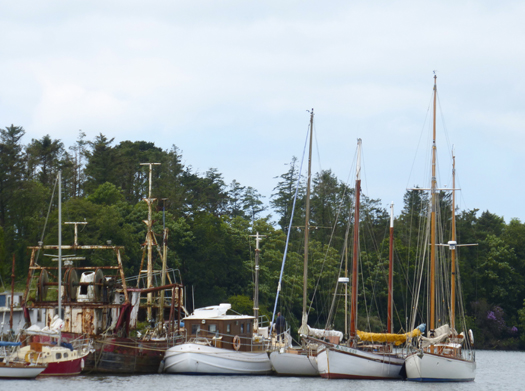
Boats in a row at Oldcourt. The further from the quay, the more ready for sea you are. Furthest out is the 1937 Tyrrell ketch Maybird, with which owner Darryl Hughes regularly attends the annual Yeats Summer School in Sligo. He's the only participant to arrive by sea, and he lives on board at the pontoon in Sligo during the Yeats festival. Photo: W M Nixon
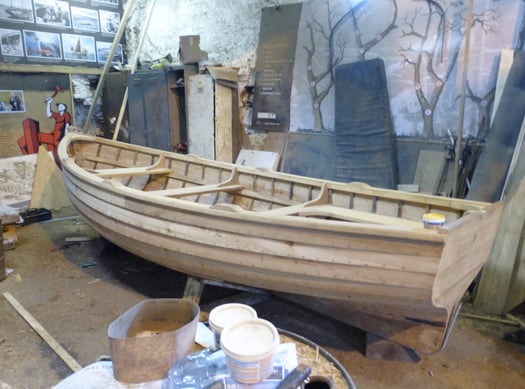
A new traditional clinker dinghy, built by John Hegarty of Oldcourt, awaits her first coast of varnish. Photo: W M Nixon
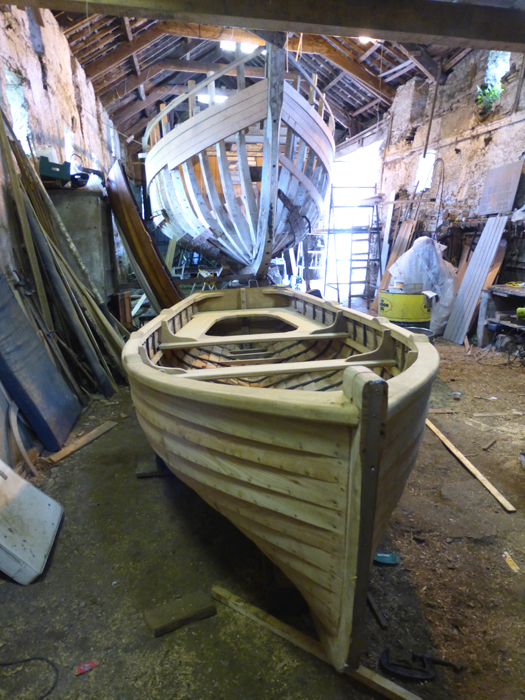
The new dinghy shares space with Conor O'Brien's Ilen, which continues to be a major work in progress. Photo: W M Nixon
Just to show what the result will be like, there was another recently-completed Hegarty dinghy in the Ilen shed, and very well it looked too. As for the restoration of Conor O'Brien's Ilen herself, that can best be described as ongoing. It has become such an absorbing task that the restoration process might best be thought of as an end in itself. Trying to work out what could most usefully be done with this hefty big lump of a boat if she ever is restored to seagoing condition is something which will require many brainstorming sessions, but it surely doesn't need to be considered in too much detail just yet.
The problem with the Ilen is she's too small for some things, and too big for others. She's of the same sort of in-between size which made the first Asgard of limited use as an official sail training vessel. Asgard was fine for teaching young people to sail, but she was simply too small to keep up with the tall ships which also completely overshadowed her in port, where Ireland's little ketch also failed to provide the necessary space and impressive setting for entertaining local bigwigs.
Manageability is the keynote to successful boat restorations. But Oldcourt is such a maritime universe that it can provide examples of what you'd think might have been eminently manageable restoration projects, yet they've ground to a halt. One such is Englyn, the creme de la crème of the boats amateur-designed by Harrison Butler, the English opthalmologist. In the 1930s, he was designing boats which successfully anticipated the highly-regarded designs of Lyle Hess more than forty years later, and the 26ft 6ins Englyn was so highly thought of by cruising guru Eric Hiscock that he included the design in his seminal book Cruising Under Sail, first published 1950.
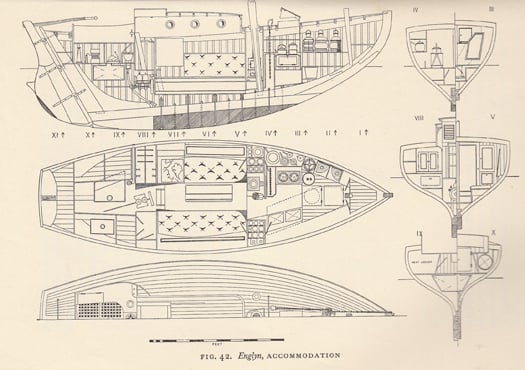
Plans of the Harrison Butler-designed Englyn, as featured in Eric Hiscock's Cruising Under Sail.
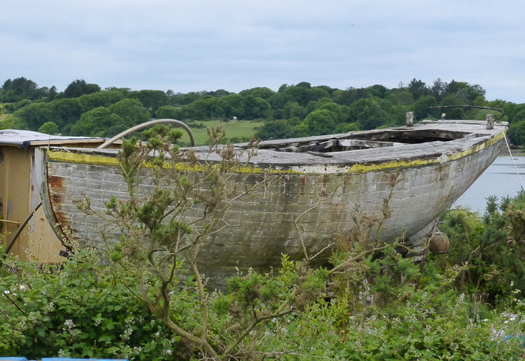
A little boat that may have missed the boat. Englyn as she is today. Photo: W M Nixon
If anything, the designs of Harrison Butler are more cherished than ever, and in this blog on May 10th we featured photos of the Harrison Butler Khamseen class cutter which ace boatbuilder Steve Morris is creating near Kilrush. It's heart-breaking to see the lines of Steve's healthy boat palely reflected in the weather-beaten remains of Englyn as she is today. But sometimes boats really can be brought back from the near-dead, and at the two-day Glandore Classic Boat Summer School in mid-July, the entire Sunday afternoon was given over to presentations about boats in various stages of restoration in and around Oldcourt.
Despite some unpleasantnesses visited upon it by the lingering death of the Celtic Tiger, Glandore gallantly soldiers on. Glandore Harbour Yacht Club's new headquarters in a cleverly rebuilt two-storey cottage up a side street (the only side street, as it happens) is appropriate to the good taste which prevails in this sweet place, whose name in Irish can mean either the golden harbour, or the harbour of the oaks - either will do very nicely.
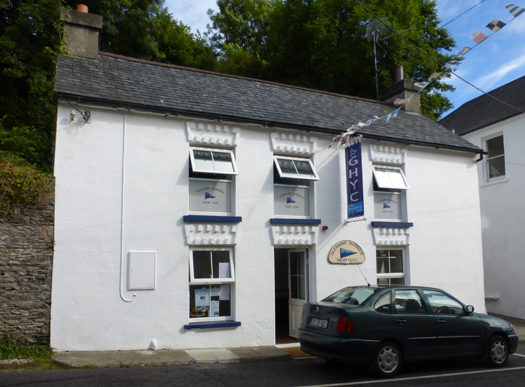
Glandore Harbour YC's clubhouse is now this cleverly re-built two-storey cottage beside the harbour. Photo: W M Nixon

The outboard dinghies waiting at the pontoon at Glandore Pier give a good indication of the number of boats based in Glandore and across the harbour at Union Hall. Photo: W M Nixon
The Summer School packed in an extraordinary variety of topics, and even this blogger was wheeled out to develop his thesis based around the ambiguous question: Why shouldn't the Irish be a seafaring people? Don't worry, for those who missed it, we'll push it out again here some time in the depth of winter. But we cannot hope to convey the full wonder of the best event in the Summer School, the question-and-answer session between ocean voyaging and offshore racing legend Don Street and his son Richard.
The old boy hasn't half been around. And if at some time your only experience of Don Street has been a high-pitched New England rant about some iniquity of modern yachting (fibreglass dismissed as "frozen snot", for instance) it's my happy duty to assure you that, as he delved into his extraordinary memories, the pitch of Don Street's distinctive voice became deeper and more resonant, until by the time he concluded all too early, we could have been listening to Captain Ahab himself.
From such a treasure trove of recollection, there were many gems, perhaps the best being about how he came to make his profession in writing about the sea and sailing. In his early days in the Caribbean before he'd put pen to paper, on one run ashore Don and his shipmates met up with Nobel Laureate John Steinbeck, and they'd a convivial time together. Later, heading back along the islands, they'd another dinner with the great writer, and during yarning at table, Don's shipmates insisted he'd so many good stories to tell that he should write them down.
"But I don't know how to spell, and I know nothing about grammar" complained Don.
"But you've a story to tell" said Steinbeck, "and you tell it well. Just you write it down, and the editors will sort out the spelling and the punctuation and the grammar. That's their job."
God be with the days......
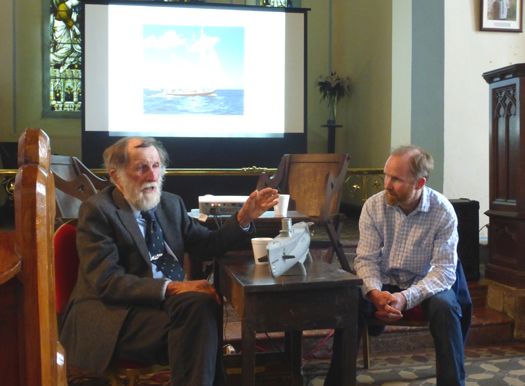
The old man of the sea – Don Street's reminiscences were the highlight of this year's Glandore Classic Boat Summer School. The school sessions were held in the harbourside church, and Don is seen here with his son Richard while he recalls his days in submarines in the US Navy. On the screen is his legendary 1905-built yawl Iolaire, in which he cruised the Caribbean and crossed the Atlantic. Photo: W M Nixon



























